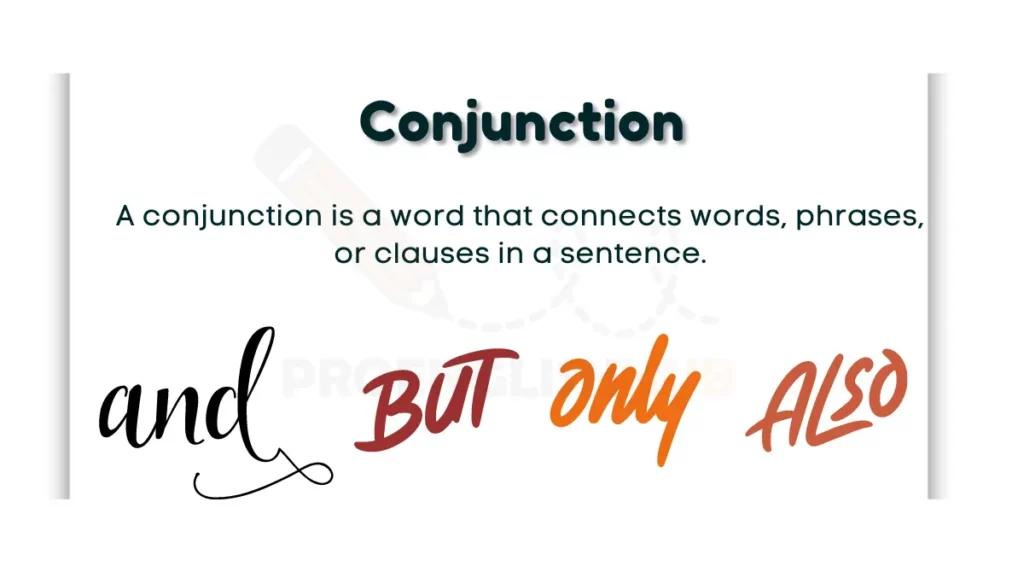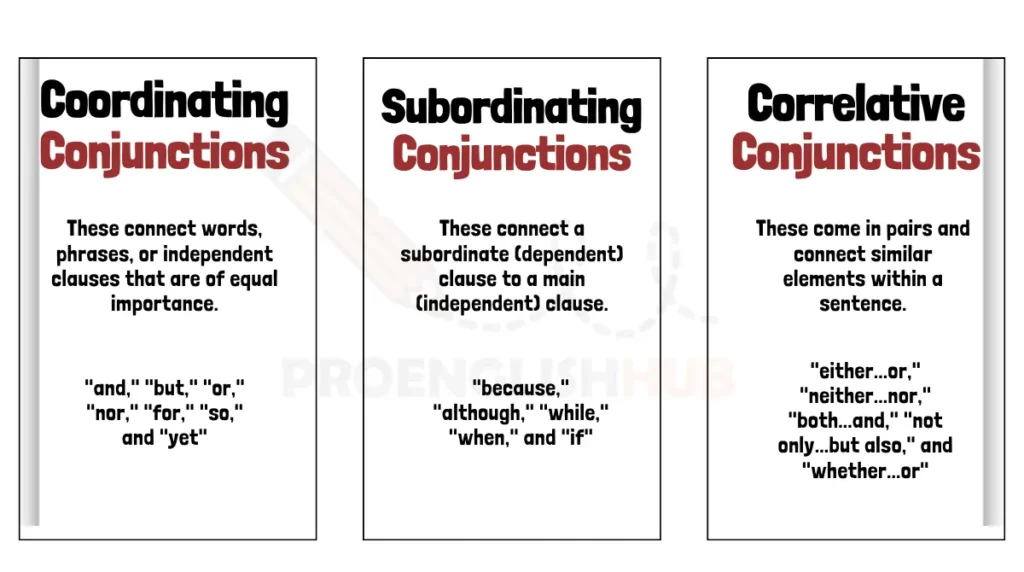Table of Contents
ToggleWhat is Conjunction?
A conjunction is a word that connects words, phrases, or clauses in a sentence. It serves to establish relationships between different elements, such as indicating addition, contrast, time, or cause and effect.

Types of Conjunctions
Here are few types of conjunction:

1. Coordinating Conjunctions
Coordinating conjunctions join words, phrases, or independent clauses of equal importance within a sentence. These conjunctions often referred as FANBOYS for easy learning. FANBOYS is an acronym that stands For, And, Nor, But, Or, Yet, and So.
Example
- Sarah loves to dance and sing.
- The weather is cold, but we’re still going for a walk.
- You can have pizza or pasta for dinner.
2. Subordinating Conjunctions
Subordinating conjunctions connect independent clauses to dependent clauses, indicating the relationship between the two. They often introduce dependent clauses and show time, cause and effect, or condition.
Example
- After the rain stopped, we went for a walk.
- She failed the test because she didn’t study.
- If you finish your homework, you can play video games.
3. Correlative Conjunctions
Correlative conjunctions are pairs of words used to link similar elements in a sentence. They work in pairs to show relationships such as addition, contrast, or alternatives.
Example
- He is not only smart but also funny.
- She prefers either chocolate or vanilla ice cream.
- Both my sister and I enjoy reading books.
4. Conjunctive Adverbs
Conjunctive adverbs are words that connect independent clauses or sentences and show the relationship between them. Conjunctive adverbs function similarly to conjunctions but are typically preceded by a semicolon or placed at the beginning of a sentence followed by a comma. They are often used to express transitions in thought, such as cause and effect, contrast, comparison, or sequence.
Example
- She studied hard; however, she still didn’t pass the exam.
- John loves to read; moreover, he enjoys writing book reviews.
- The weather was cold; therefore, we decided to stay indoors and watch movies.
Rules for using Conjunction
Here are some rules for using conjunctions.
- Use conjunctions like “and” to join words, phrases, or sentences that express similar ideas or actions. For example, “I like to swim and hike.”
- Use conjunctions like “but” to connect contrasting ideas or actions. For example, “She is shy, but she is also very kind.”
- Use conjunctions like “or” to present alternatives or choices. For example, “Do you want tea or coffee?”
- Use conjunctions like “and,” “but,” or “or” to connect independent clauses and form compound sentences. For example, “He ran to catch the bus and he arrived just in time.”
- Use conjunctions like “because” to show the reason for something happening. For example, “She couldn’t sleep because the room was too noisy.”
- Use conjunctions like “if” to introduce conditions or hypothetical situations. For example, “I’ll go to the party if I finish my work on time.”
- Use conjunctions like “when” or “after” to connect events or actions that occur in a specific sequence. For example, “She went to bed after she finished her homework.”
- When joining two independent clauses with a coordinating conjunction like “and,” “but,” or “or,” use a comma before the conjunction. For example, “She likes to swim, and she enjoys hiking.”
- When connecting two independent clauses with a conjunctive adverb like “however,” “moreover,” or “therefore,” use a semicolon before the adverb, followed by a comma after it. For example, “He wanted to go outside; however, it was raining heavily.”
- Do not use a comma to join two independent clauses without a conjunction or conjunctive adverb. This error is called a comma splice. For example, “She loves to read, she also enjoys writing.”
- When using coordinating conjunctions to connect items in a list, ensure that the items have parallel structure. This means they should be in the same grammatical form. For example, “She enjoys swimming, hiking, and biking.”
- Choose the appropriate conjunction based on the context and the relationship you want to convey between the elements of your sentence. For example, use “and” to add information, “but” to show contrast, “or” to present alternatives, and so on.
Usage in sentence
- She enjoys reading and writing poetry in her free time.
- He is smart but sometimes lacks confidence in himself.
- Would you like to have pizza or pasta for dinner tonight?
- She studied hard, yet she still didn’t pass the exam.
- He loves both playing soccer and watching basketball.
- The weather was sunny but quite chilly in the evening.
- We can either go to the beach or have a picnic in the park.
- She finished her homework early, so she could go out with her friends.
- He wanted to travel to Europe but couldn’t afford the plane ticket.
- They went hiking and camping over the weekend.
Also Read:


